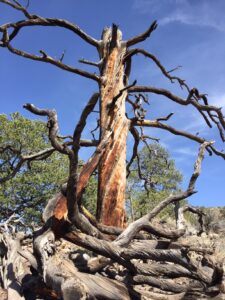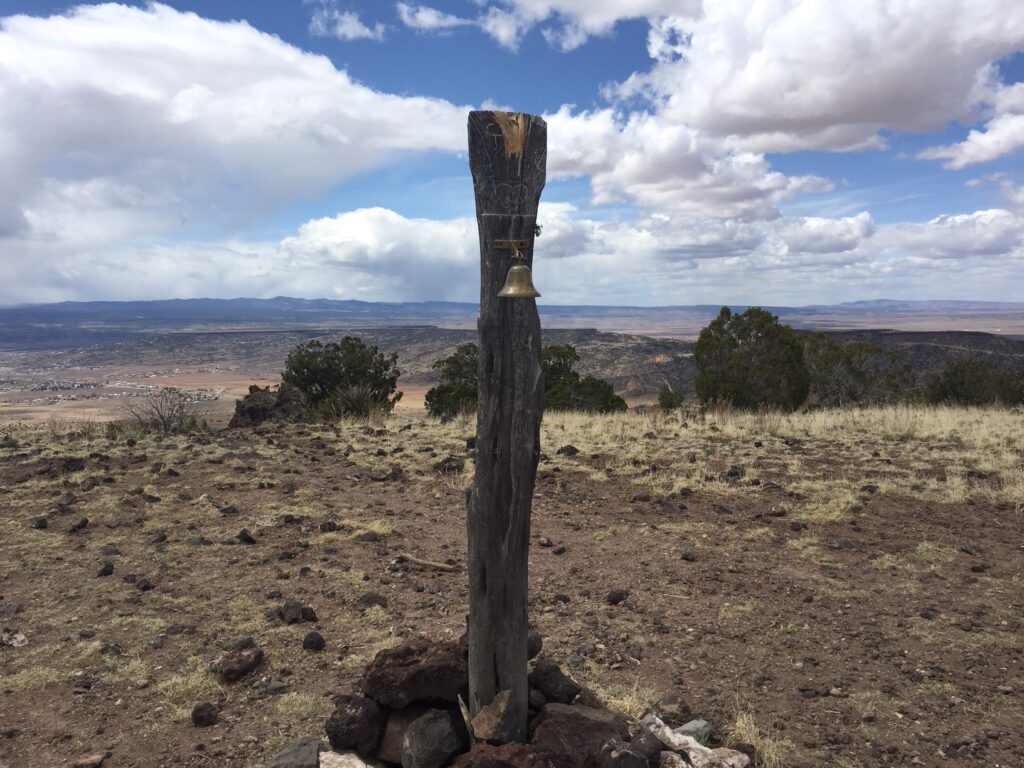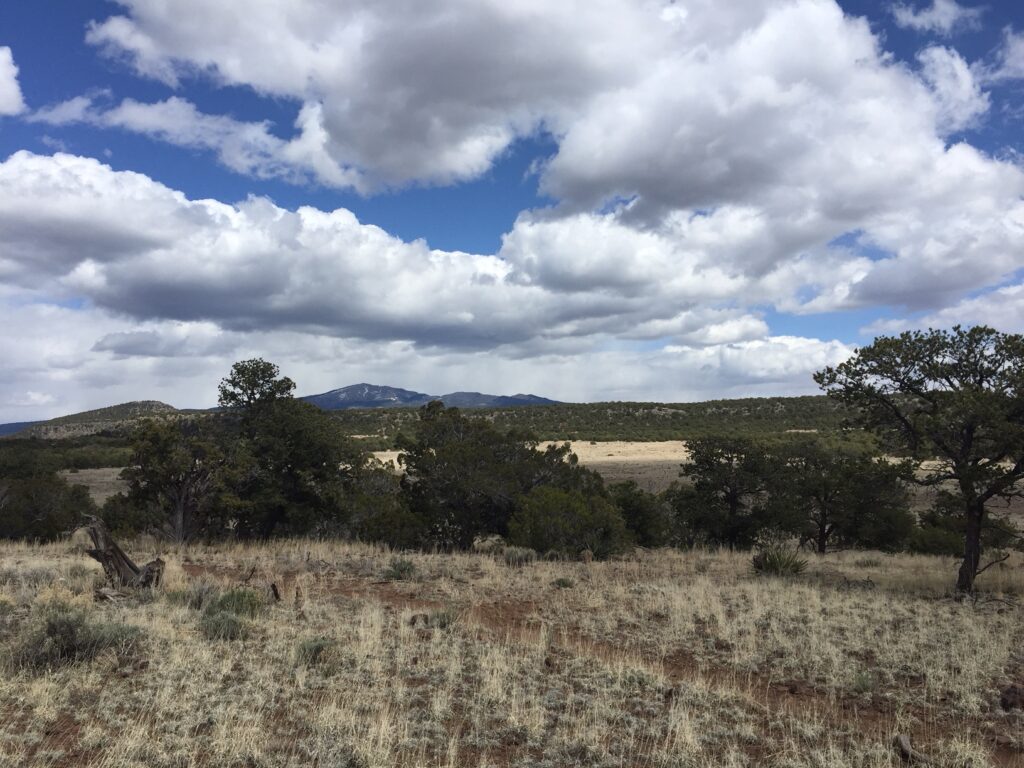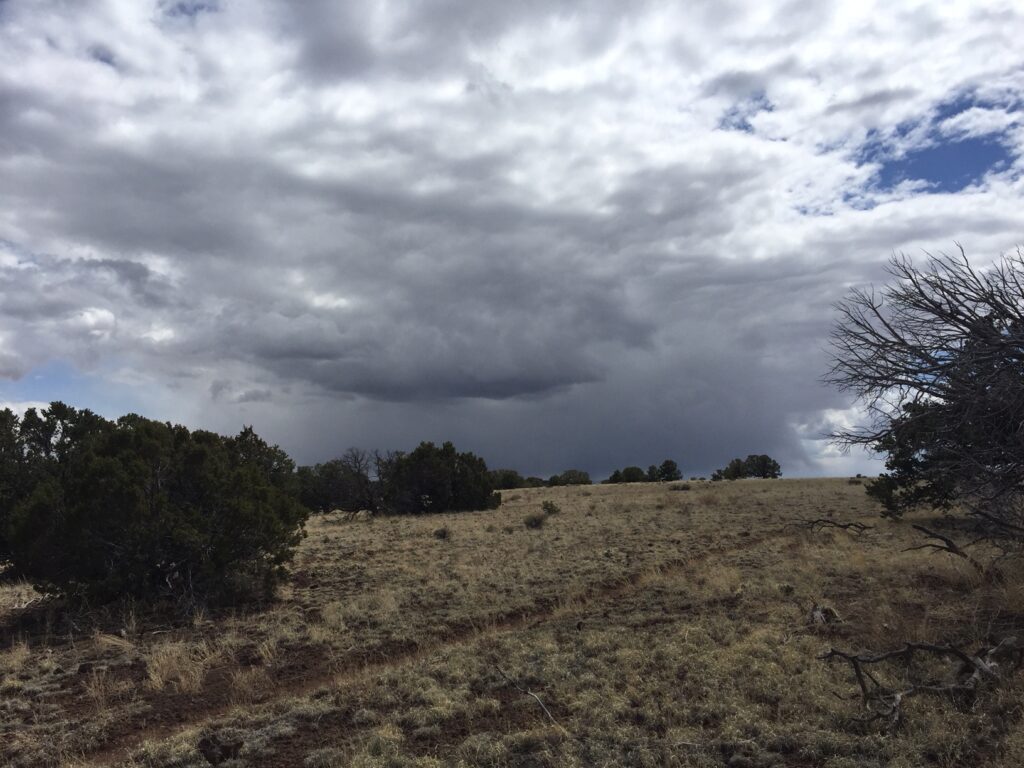the great divide
Driving west from Albuquerque is infinitely better than the travel videos I’ve been watching online. Rolling across the easy hills like a tumbleweed, I pass through one entrancing vista after another, sipping ginger lemonade and humming along with the stereo from the best seat in the house. The afternoon light is more honest than video, highlighting the soft green of new growth dusting the desert in early May, growing hazy and indistinct as I look to the far off mesas, their stair-stepped horizon.
All along the highway, electric signs flash warnings that Gallup is still locked down, “no services available.” My daughter lives in Gallup with her family, at the epicenter of New Mexico’s current coronavirus outbreak. Temporarily under siege, she assured me over the phone that she planned for the long haul on her last shopping trips, stocking her pantry with non-perishables. But the kids are so small, just 5, 3, and the little one having her first birthday this weekend. They don’t have ice cream for her big day; they don’t understand why Mommy won’t give them more baby carrots and apples, rationing the fresh produce to make it last. I taste the extravagance of my lemonade as I finish it off. I have veggie chips and an apple in my daypack.
I take the Quemado exit but turn right, skirting the small, rundown town of Grants, turning right again at the storage units, following the signs toward Mount Taylor. I pass the privatized local jail facility, “CoreCivic” proclaimed on the gate; that’s the truth, I think. Between Grants and neighboring Milan, you can count three sites for incarceration, two of them on this road.
I note another sign just before I pass the larger prison complex. “Do not pick up hitchhikers in this area.” The shoulder of the road widens for inexplicable reasons, the next sign noting, “No stopping except for emergencies.” I think I would drive on a flat tire rather than stopping in front of this razorwire-bound fortress.
The prison is a landmark I watch for, ironically, telling me I’m almost to the gates of freedom. Around two curves of the road, I see the National Forest sign: “Continental Divide Trail.” Following the Rockies high and low, the Continental Divide marks the North American watershed, dividing waters flowing west to the Pacific and those flowing east to the Gulf of Mexico and the Atlantic. I turn right a third time, onto a short, deeply rutted dirt road into a dirt parking area that is always sparsely populated.
I’m learning to judge my trail access by the way vehicles are parked. If a couple of dependable, used SUVs are aligned faced into the boundary fence, a few hikers are on the trail. If an older pickup with a topper is backed into the farthest corner, hiding its license plate and activities, that could be anything from someone staying overnight to drug dealing to do-it-yourself shooting range, using your empties as targets. Today, a ratty compact sedan with no hubcaps is the only vehicle, parked dead center in the lot, angled for a quick escape. Sure enough, as I park at the boundary fence, three young guys immediately exit nearby brush, carrying on a forced conversation about absolutely nothing in voices tuned to be heard. Clearly up to no good, I watch them load into the car and peel out, tires throwing rocks, straining the buzzy engine of the sun-bleached little Mazda as they hightail it down the highway. I strap on my pack, click the beeping lock button on my car key, and stride through the gate and up the steep trail, moving fast, wanting to remain unseen just in case they decide to come back.
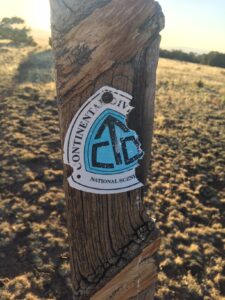 It’s 3:30 on a mellow Friday afternoon, perfect, sunny, a cool breeze keeping the temperature in the mid-70’s. Having put in extra hours at the beginning of the week, I’d let my boss know I’d be leaving early today, and he’d encouraged me to go.
It’s 3:30 on a mellow Friday afternoon, perfect, sunny, a cool breeze keeping the temperature in the mid-70’s. Having put in extra hours at the beginning of the week, I’d let my boss know I’d be leaving early today, and he’d encouraged me to go.
It’s weird having a steady job during this second Great Depression. Over 33 million Americans have filed for unemployment in the last seven weeks. I’ve been reading the New York Times: one in six Americans has lost their job in the pandemic, and the number will only grow.
Millions of people have filed for public assistance benefits in the past two months, in some states double the total applications for all of 2019. Cars fill stadium parking lots across our country and stretch two and three miles as people wait hours for food boxes. “Mortgage loan servicers,” the new name for predatory lenders, prowl like wolves. The working poor continue to rack up debt as they wait, hoping to be recalled to their hourly jobs.
My hiking trail winds around the edge of an incredibly steep hillside. Shrubs I do not recognize, with tiny green slivers of leaves, pink buds, and small four-petal crosses of white flowers, cling just below the narrow path amidst the rocks and cactus, offering a hint of fragrance. They are cliff fendlerbush, awkwardly named for Augustus Fendler, “the first academically trained botanist to collect plants in and around Santa Fe, New Mexico,” in 1846, according to the Forest Service. The prettier name is Navajo orange, K’iishzhiní, listed on New Mexico State University’s website “Selected Plants of Navajo Rangelands.” I like the Navajo word best, the soft sound capturing the sweet enchantment of this unexpected garden along such a treacherously narrow margin. I find this bush’s tenacious optimism encouraging.
Less than an hour on the trail, I step beyond the scraggly junipers to reach the mesa summit. Here you can take in a panoramic view to the south, layers of hills slowly fading into the distance. Foothills of Mount Taylor block my view to the east, toward Gallup. However, mere steps to the west, on a tall post held steady in the center of a rock pile, someone has attached an old brass bell. It hangs at about face height, patiently waiting over the course of years for the dusty human beings who’ve made it this far to ring out the sound of their existence over the valley below.
Every bell is a bell of mindfulness, asking me to pay attention, like the Vietnamese Buddhist monk Thich Nhat Han has tried to teach me through his books. I pick up a rock and tap the bell, and a soft, sweet note rings gently, a fragile voice that whispers away on the wind: K’iishzhiní.
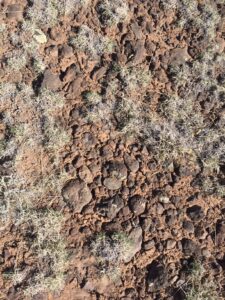 After a drink of water, the trail leads me north across the open tableland, evergreen scrub circling the edges of the mesa. Here, grass grows in dry tufts scattered among a vast cobble of volcanic rocks. The trail gently sways to the left and right, like a cow path through pasture. Nearby lies evidence that this may indeed be the origins of this stretch of trail: dessicated cow dung bleached nearly white, their cloven hoofprints hardened in the dry orange clay by the ever-present wind and sun.
After a drink of water, the trail leads me north across the open tableland, evergreen scrub circling the edges of the mesa. Here, grass grows in dry tufts scattered among a vast cobble of volcanic rocks. The trail gently sways to the left and right, like a cow path through pasture. Nearby lies evidence that this may indeed be the origins of this stretch of trail: dessicated cow dung bleached nearly white, their cloven hoofprints hardened in the dry orange clay by the ever-present wind and sun.
Out of habit, I scan the treeline, watchful for wildlife, friend or foe. I’ve picked up a walking stick along the way, weathered grey, worm-trailed, but solid at its core. On my last hike up here, I’d found what looked like bobcat or coyote scat, full of rodent fur and tiny bones. But today, my only companions are birds, ravens overhead, warblers and sparrows singing from their distant branches. I pass through the first line of trees and across the next lower mesa. I wend my way through more juniper and split cedar.
Now coming over a rise, I see a pristine valley opening to my right. No roads, no fencelines, the kind of high meadow within tree-covered hills favored by elk. This is as far as I’ve been on the trail to-date, and I happily continue around the next hillside.
The landscape becomes more of a low forest, and the farther I hike, the taller the trees grow, short-needled fir, spruce, and white pine, until I’m suddenly surprised to find myself on the top of yet another rounded mesa in a spreading grove of nothing but fat piñon. Just as I think it, I see it: elk droppings beside the path. I venture on, tall trees rising once again, white pines stretching higher, wondering if those are ponderosa I see, the harbingers of mountain trails.
As I reach a small gap in the forest, I notice two things nearly simultaneously: a view of Mount Taylor, looking closer and more attainable than ever, and another Continental Divide Trail marker nailed to a tree. This one’s a tiny little pine, with two angled branches of thickness similar to the central leader, all splitting from the same location. The effect is of a hand holding up three fingers, like a reminder of something, something I’ve lost count of. I look at Mount Taylor, pondering the little tree while perched on a low limb of a particularly spectacular piñon, the ground under my daypack littered with its wasted abundance. I nibble my veggie chips and chomp into my apple.
It’s 6:00. I have to turn around if I want to get down before dark. But how I wish I could just keep going, for days. I imagine hoisting my larger backpack, tent and sleeping bag secured, and wandering away, away from the day job I am lucky to have, away from cars and video screens and politics and reactionary people fearful of the unknown that lies ahead of us all.
At least I have walked beyond my worries today. Zipping my daypack, I feel wistful as I turn back, 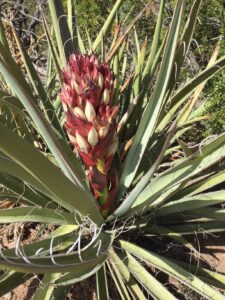 and something else, something stirring within.
and something else, something stirring within.
Tapping along with the walking stick for an hour or so, I meet a young woman on the open mesa. From a distance I note the big pack, rain jacket, and quick-dry shorts. As she approaches, I see a carton of what I presume are hard-boiled eggs lashed to the top of her backpack. I step aside, giving her safe distance to pass.
“Have you seen anybody else on the trail?” she asks me by way of a greeting. A familiar style of greeting. And as she says it, I feel joy, as if I have come home.
“No, nobody,” I smile at this stranger. “How far you going?”
“Just to Cuba.”
“How far is that?”
“Mmm, maybe 90 miles.” She cocks her head back and forth between empty hands like scales, the gesture of the we’ll-see-guesstimate: “I’ve got food for five days.”
“You’ve done the Continental Divide Trail before, the whole way?”
“Oh yeah. I’ve done all of them.” She grins, the pink streak in her blond hair shining in the afternoon sun. “I’m one of those people.”
I smile broadly. You’re one of my people. Before we part, she tells me that since she’s now unemployed, she’s heading back onto the trails, reconnecting to that part of herself she loves 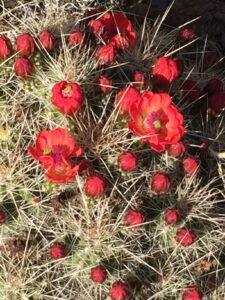 most and has neglected in the city.
most and has neglected in the city.
And there it is.
It’s been three years since I went trekking across Spain. Signs and messages come in threes. As do prisons.
So many things cancelled, locked down. It’s hard to feel free. Yet my first book still goes to the editor in July. Ring the bell: I’ve made it this far.
Maybe I could follow that familiar stranger, joy, hike over Mount Taylor, all the way to Cuba, or beyond. Use some paid time while I have it. While I’m well. While I wait to hear what comes next.
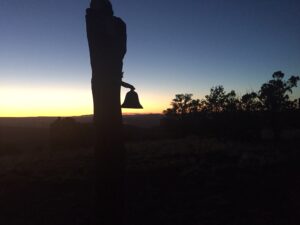 As I reach the overlook, I turn right, to face the setting sun. Standing in the warm rosy glow, chewing on a twig of sweet-tasting Navajo orange, I contemplate the unexpected abundance of my life, spent constantly walking the Great Divide.
As I reach the overlook, I turn right, to face the setting sun. Standing in the warm rosy glow, chewing on a twig of sweet-tasting Navajo orange, I contemplate the unexpected abundance of my life, spent constantly walking the Great Divide.
Water only flows to one sea or the other. But first, it comes to us as rain. In this way, somehow even the desert blooms.
K’iishzhiní, whispers the evening breeze.
